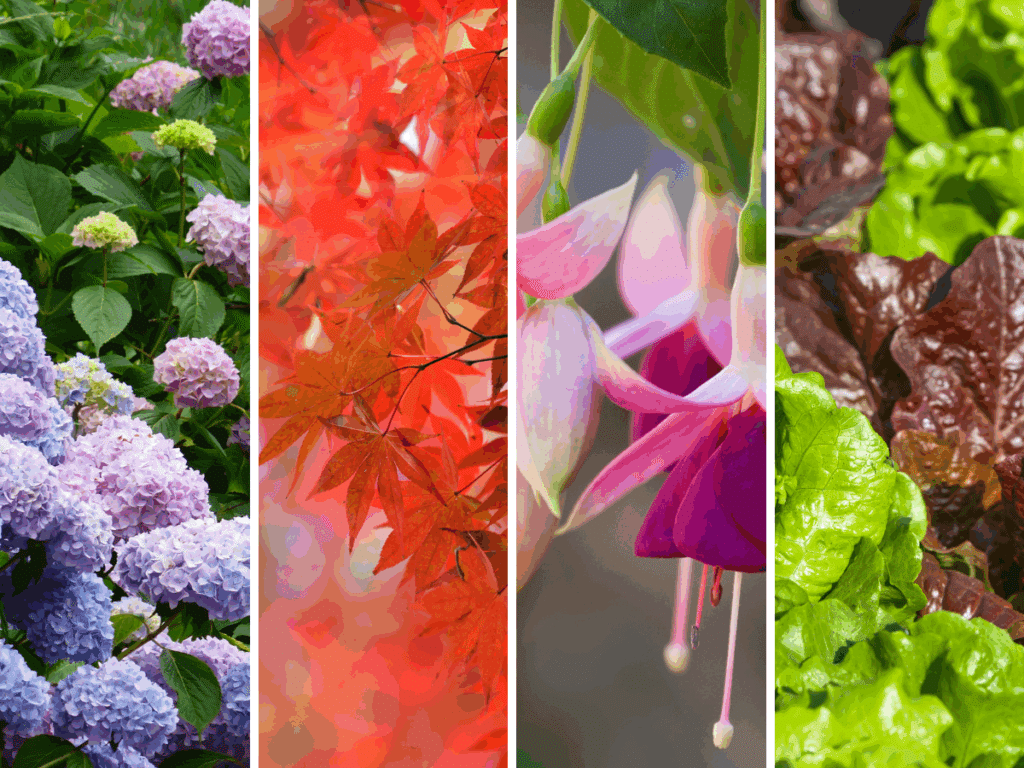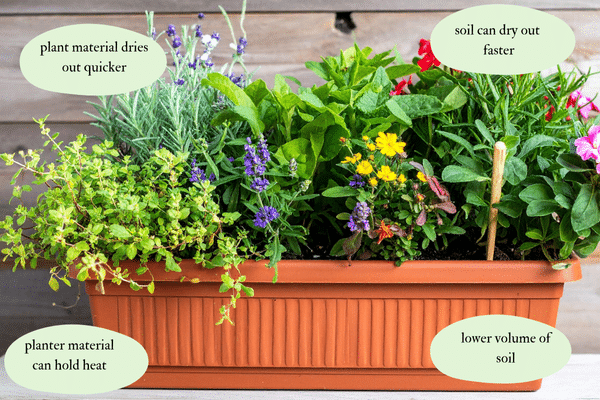How to Identify and Protect Heat-Stressed Plants in Summer’s Hottest Days
IN THIS ARTICLE YOU WILL FIND…
We discuss a common experience; the fact that summer heat can push even the hardiest plants to their limits. We want our lovely gardens to last out the growing season. Here’s how to spot trouble early, protect vulnerable species, and tailor your care for both plants in the ground and in containers.
How Heat Stress Shows Up!
Recognizing Heat Stress in Plants
When temperatures soar, plants can suffer just like we do. Heat stress disrupts their growth, their water uptake, and overall vitality—especially if paired with drought conditions. Spotting early warning signs can help you intervene before lasting damage is done.
Some Plants Susceptible to Heat Stress

| Plant Type | Heat Risk | Notes |
| Hydrangea | High | Wilts easily, prefers moist soil |
| Japanese Maple (Acer) | High | Leaf scorch common |
| Fuchsia | High | Sensitive to direct sun |
| Lettuce, Spinach | High | Bolts quickly in heat |
| Tomatoes & Peppers | Moderate | Susceptible to sunscald and blossom drop |
| Succulents & Cacti | Low | Naturally heat-tolerant |
Container vs. In-Ground Plants: Heat Risks & Care
Container Plants
You will find your plants in containers to be more sensitive to changes in temperature than plants in the ground. The smaller amount of soil and the material encasing it are primarily responsible.

- Higher risk: Soil heats up and dries out faster.
- Protection tips:
- Move to partial shade or indoors during peak heat.
- Water deeply in the morning and again in the evening if temps exceed 95°F.
- Use mulch or top dress with gravel to retain moisture.
- Elevate pots for airflow and avoid dark-colored containers that trap heat.
In-Ground Plants
- Lower risk, but still vulnerable during prolonged heat waves.
- Protection tips:
- Apply 2–4 inches of organic mulch to insulate soil.
- Water deeply and less frequently to encourage deep root growth.
- Avoid pruning, fertilizing, or transplanting during extreme heat.
- Use shade cloth or plant taller companions to shield sensitive crops.
Extra Summer Survival Tips
- Group container plants together to create a microclimate.
- Use ice cubes at the base of container plants for slow hydration.
- Avoid watering leaves during peak sun to prevent scorch.
- Skip fertilizing until temperatures cool—new growth is vulnerable.
Do You Want Some Help Choosing Heat-Tolerant Plants or Setting Up a Shade System?
I’ve got some ideas that will keep your garden thriving even when the sun is relentless.
Best Practices for Watering Plants in Extreme Heat & Humidity
When the sun is blazing and the air feels like you are walking in soup, your plants need a hydration strategy that’s smarter; not just wetter. Here’s how to keep them thriving:
Watering Tips for Hot & Humid Conditions

- Water Early Morning (5–9 AM)
This minimizes evaporation and gives plants time to absorb moisture before the heat spikes. - Choose Deep Watering Over Frequent Sprinkles
Soak the soil several inches deep to encourage deep root growth. Shallow watering leads to weak, surface-level roots. - Avoid Wetting Leaves
In humid conditions, wet foliage can invite fungal diseases. Focus water at the base. - Mulch Generously
Apply 2–4 inches of organic mulch (like straw or wood chips) to retain moisture and cool the soil. - Use Soaker Hoses or Drip Irrigation
These deliver water directly to roots with minimal waste and reduce leaf wetting. - Check Soil Moisture Before Watering
Stick your finger 2 inches into the soil. Sacrifice a manicure for your plants! If it’s dry down there, it’s time to water. Moisture meters are even better. - Group Container Plants Together
This creates a microclimate that retains humidity and reduces stress. - Shade Sensitive Plants
Use shade cloth (30–50%) or umbrellas during peak heat to reduce transpiration.
Good Examples of Heat-Tolerant Plants
These plants are remarkably unaffected by extreme heat.
| Plant | Type | Heat Traits |
| Lantana | Perennial | Thrives in full sun, drought-tolerant |
| Bougainvillea | Shrub/Vine | Loves heat, minimal water once established |
| Coneflower (Echinacea) | Perennial | Deep roots, blooms in high heat |
| Salvia | Perennial | Attracts pollinators, heat-hardy |
| Blanket Flower | Perennial | Tolerates poor soil and intense sun |
| Agave | Succulent | Stores water, thrives in arid heat |
| Pentas | Annual | Blooms through heat and humidity |
| Portulaca (Moss Rose) | Succulent | Excellent for containers, drought-tolerant |
| Coreopsis | Perennial | Long bloom time, handles heat well |
| Desert Marigold | Perennial | Thrives in rocky, dry soil |
My Short Guide to Identifying and Caring for Heat-Stressed Plants
What Is Heat Stress
Plants become heat-stressed when temperatures exceed their comfort zone—typically above 30 °C (86 °F) by day and stay warm at night. Under these conditions, plants struggle to cool themselves through transpiration and conserve resources.
Common Symptoms
- Wilting or drooping despite moist soil
- Leaf rolling or cupping to reduce surface area
- Brown, scorched leaf margins
- Premature flower or fruit drop
- Pale or bleached spots from sunscald
Preventive Care
- Morning deep watering to reach roots and reduce evaporation
- 5–8 cm (2–3 in) of organic mulch to moderate soil temperature
- Shade cloth or umbrellas to filter intense sun
- Enrich soil with compost for better moisture retention
- Choose heat-tolerant varieties and space plants for airflow
Emergency Measures
- Drape temporary shade sails or row covers over vulnerable plants
- Lightly mist the air (not foliage) for evaporative cooling
- Use self-watering pots or group containers to create a humid microclimate
- Delay pruning, heavy feeding, and harvesting until temperatures drop
Recovery Steps
- Prune away dead or irreparable leaves with clean tools
- Gradually return to regular watering once heat subsides
- Inspect for opportunistic pests and diseases and treat promptly
Summary,
By spotting early signs and blending proactive and reactive care, your garden can weather summer heat with minimal damage.

Heat stress in plants often reveals itself through a combination of visible leaf damage and changes in growth patterns. Leaves may wilting during the hottest part of the day, exhibit brown or bleached patches (especially along margins), and curl inward as a defense against moisture loss. You might also notice stunted internode elongation or flower/fruit drop as the plant diverts energy away from reproduction toward survival. Soil that bakes dry within hours or ambient temperatures regularly exceeding a plant’s tolerance thresholds are key environmental cues pointing to heat-induced distress.
Immediate care for heat-stressed specimens centers on reducing temperature extremes and ensuring consistent hydration. Shading vulnerable crops or ornamentals—using shade cloth, temporary umbrellas, or positioning pots under taller foliage—can lower leaf temperatures by several degrees. Deep, infrequent watering helps sustain root function without encouraging shallow roots that dry out quickly; mulching further conserves moisture and buffers soil against rapid heating. Misting or deploying small fans to improve air circulation around foliage can also ease heat load, though humidity levels must be watched to prevent fungal issues.
Long-term strategies focus on building resilience before the mercury climbs. Selecting varieties bred for heat tolerance, amending soil with organic matter to improve water-holding capacity, and planting in optimal seasons or microclimates (east/west beds, sheltered corners) all contribute to robust performance under heat pressure. Regular monitoring—checking soil moisture at root depth, tracking heat-wave forecasts, and observing leaf behavior—allows you to anticipate stress and intervene early. Over time, these proactive measures not only minimize heat damage but also support healthier, more productive plants even in sweltering conditions.
Happy Digging,
Jane

